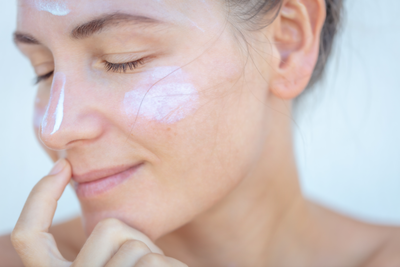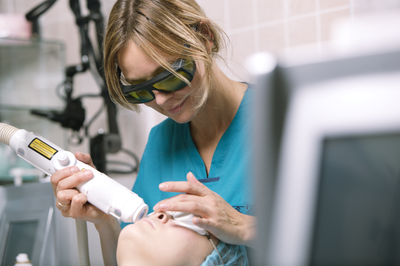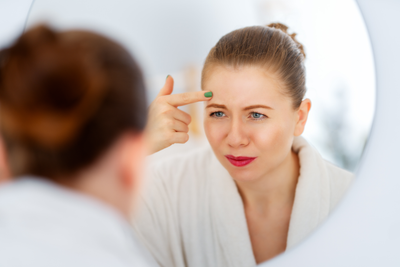Understanding Fine Lines and Their Causes
The Difference Between Fine Lines and Wrinkles
At first, I wasn't sure about the difference between fine lines and wrinkles, but then I discovered that fine lines are the initial stage of skin aging, while wrinkles are deeper and more pronounced. Fine lines usually appear around the eyes, mouth, and forehead due to the natural aging process, sun damage, and repetitive facial expressions. On the other hand, wrinkles are deeper creases that occur with a loss of skin elasticity and collagen and elastin production.
By understanding the distinction between fine lines and wrinkles, I realized that I needed a specific approach to address my skin care for fine lines. The right combination of active ingredients, such as retinol and hyaluronic acid, can help smooth fine lines and prevent them from turning into deep wrinkles. I also learned about the importance of sun protection and keeping my skin moisturized to maintain its overall health and reduce the signs of aging.
Common Causes of Fine Lines
As I explored the common causes of fine lines, I found that exposure to ultraviolet (UV) radiation from the sun was a significant factor in skin aging. Sun damage can cause a loss of skin elasticity, leading to the formation of fine lines and wrinkles. In addition, other lifestyle factors like smoking, poor diet, and lack of sleep can contribute to the appearance of fine lines. These factors can generate free radicals, which can damage skin cells and accelerate the natural aging process.
Furthermore, repetitive facial expressions, such as smiling, frowning, or squinting, can lead to the development of fine lines over time. By addressing these causes, I was able to create a more effective skincare routine tailored to my needs. This included incorporating products with antioxidants, like vitamin C and E, to neutralize free radicals, and using a broad-spectrum sunscreen daily to protect my skin from sun damage.
The Role of Genetics and Lifestyle Factors
I learned that genetics also play a significant role in the formation of fine lines. Some people may be more predisposed to developing fine lines and wrinkles due to their genetic makeup. However, by adopting a healthy lifestyle, I can minimize the impact of genetics on my skin's appearance. This includes maintaining a balanced diet, getting regular exercise, and ensuring adequate sleep to support my skin's natural repair processes.
Stress is another factor that can affect skin health, as it can trigger the production of cortisol, a hormone that breaks down collagen and elastin, leading to sagging skin and fine lines. By managing my stress levels through practices like meditation, yoga, and deep breathing exercises, I can help maintain my skin's health and slow down the formation of fine lines and other signs of aging.
The Importance of a Tailored Skincare Routine
Identifying Your Skin Type
Before I could create a tailored skincare routine to address my fine lines, I needed to identify my skin type. I discovered that there are various skin types, including oily, dry, combination, and sensitive skin. Each skin type requires a different approach to skincare, as using the wrong products can exacerbate existing issues or even cause new ones. For example, someone with oily skin might require a lightweight, oil-free moisturizer, while those with dry skin may need a richer cream to provide adequate hydration.
By understanding my skin type, I was able to choose products that were specifically formulated to address my unique needs. This not only helped me combat fine lines more effectively, but also improved my overall skin health, giving me a more radiant and youthful appearance.
Choosing the Right Skincare Products
Once I had identified my skin type, I set out to find the best skincare products for my needs. I learned that it's essential to look for products that contain active ingredients proven to reduce fine lines, such as retinol, hyaluronic acid, alpha hydroxy acids, and peptides. These ingredients work together to boost collagen production, stimulate cell turnover, and hydrate the skin, which can smooth out fine lines and prevent them from becoming deep wrinkles.
I also made sure to consider the different skin benefits that various products could offer, such as improving skin tone, targeting dark spots, and providing hydration. By choosing products that addressed multiple concerns, I was able to create a more streamlined and efficient skincare routine without overloading my skin with too many products.
Creating a Customized Routine for Fine Line Management
Armed with knowledge about my skin type and the most effective ingredients for reducing fine lines, I was ready to create my customized skincare routine. I began by selecting a gentle cleanser that removed dirt and impurities without stripping my skin of its natural oils. Next, I incorporated an exfoliating product containing lactic or glycolic acid to remove dead skin cells and reveal a smoother, more even skin tone.
After cleansing and exfoliating, I applied a vitamin C serum to protect my skin from free radicals and improve its radiance. I then used a hydrating hyaluronic acid serum to provide my skin with intense moisture, followed by a wrinkle cream containing retinol to stimulate collagen production and reduce the appearance of fine lines. Finally, I sealed in all the active ingredients with a nourishing night cream, ensuring that my skin would be well-hydrated and rejuvenated as I slept.
Effective Ingredients for Fine Line Reduction
Retinol: A Skincare Staple
Throughout my journey to find the best solutions for fine lines, I discovered that retinol is a must-have ingredient. As a derivative of vitamin A, retinol helps to stimulate collagen production, increase cell turnover, and improve skin elasticity. By incorporating a retinol cream into my routine, I noticed a visible reduction in my fine lines, and my skin appeared smoother and more youthful.
When using retinol, it's essential to start with a low concentration and gradually increase the strength to minimize the risk of irritation. I also made sure to apply sunscreen daily, as retinol can make the skin more sensitive to sun damage.
Peptides and Their Role in Collagen Production
I learned that peptides are small chains of amino acids that serve as building blocks for proteins, including collagen and elastin. By incorporating products containing peptides into my skincare routine, I was able to boost collagen production and improve my skin's firmness and elasticity. This, in turn, helped to smooth out fine lines and prevent new ones from forming.
Peptides can be found in a variety of skincare products, such as serums, creams, and eye treatments. I made sure to select products with a high concentration of peptides to maximize their effectiveness in addressing my fine lines.
Natural Alternatives: Antioxidants and Essential Oils
Essential oils, such as rosehip oil, lavender oil, and frankincense oil, can also be beneficial in addressing fine lines. These oils have anti-inflammatory, hydrating, and regenerative properties that can help nourish the skin and support its natural repair processes. When using essential oils, I made sure to dilute them with a carrier oil, like jojoba oil or sweet almond oil, to avoid potential irritation and ensure optimal absorption.
Preventative Measures for Fine Lines

Sun Protection: The Importance of SPF
Throughout my journey to improve my skin's appearance, I discovered that sun protection is a critical preventative measure for fine lines. Prolonged sun exposure can cause premature skin aging and damage collagen and elastin fibers, leading to the formation of fine lines and wrinkles. By using a broad-spectrum sunscreen with at least SPF 30, I was able to protect my skin from harmful UV rays and minimize the risk of developing fine lines and other signs of aging.
It's essential to apply sunscreen daily, even on cloudy or rainy days, as UV rays can penetrate through clouds and windows. I also made sure to reapply sunscreen every two hours or immediately after swimming or sweating to maintain consistent protection.
Hydration: Drinking Water and Using Moisturizers
Another critical preventative measure for fine lines is maintaining proper hydration, both internally and externally. Drinking enough water throughout the day helps to keep the skin plump, reducing the appearance of fine lines. In addition to staying hydrated from within, I made sure to moisturize my skin daily with a product suited to my skin type.
By using a moisturizer containing hydrating ingredients like hyaluronic acid and shea butter, I was able to lock in moisture and maintain my skin's natural barrier, preventing dehydration and the formation of fine lines. This not only helped to improve the appearance of my existing fine lines, but also prevented new ones from developing.
Managing Stress and Its Impact on Skin Health

Managing stress is another crucial factor in preventing fine lines, as stress can lead to the release of cortisol, which breaks down collagen and elastin fibers. By incorporating stress-relief techniques into my daily routine, such as meditation, deep breathing exercises, and yoga, I was able to reduce my stress levels and support my skin's natural repair processes.
Additionally, getting enough sleep is essential for maintaining skin health, as the body repairs and regenerates itself during sleep. By prioritizing rest and relaxation, I was able to create an environment that allowed my skin to rejuvenate and maintain a youthful appearance.
Incorporating Professional Treatments
Chemical Peels and Microdermabrasion
As part of my efforts to reduce fine lines, I also explored professional treatments such as chemical peels and microdermabrasion. Chemical peels use acids like glycolic acid or lactic acid to remove the top layer of dead skin cells, revealing smoother, more radiant skin beneath. This treatment can help reduce the appearance of fine lines by promoting cell turnover and improving skin texture. I made sure to consult with a board-certified dermatologist to determine the appropriate type and strength of chemical peel for my skin concerns and sensitivity level.
Microdermabrasion is another professional treatment I considered for fine line reduction. This procedure involves using a specialized device to exfoliate the skin's surface, removing dead skin cells and promoting cell regeneration. Like chemical peels, microdermabrasion can help to smooth out fine lines and improve overall skin tone and texture. I sought advice from a cosmetic dermatology professional to ensure that microdermabrasion was a suitable treatment for my skin type and concerns.
Laser Treatments: What to Expect

Laser treatments are another option I explored for addressing fine lines. These non-invasive procedures use targeted light energy to stimulate collagen production and promote skin rejuvenation. There are various types of laser treatments available, each with its unique benefits and potential side effects. Fractional laser treatments, for example, can help to resurface the skin and reduce the appearance of fine lines, sun damage, and acne scars.
Before undergoing any laser treatments, I made sure to consult with a board-certified dermatologist to discuss my specific skin concerns and determine the most appropriate treatment plan. It's essential to understand the potential risks and downtime associated with laser treatments, as well as the number of sessions needed to achieve the desired results.
Injectables: Botox and Dermal Fillers
Injectable treatments, such as Botox and dermal fillers, are another option for those seeking to reduce the appearance of fine lines. Botox works by temporarily relaxing the facial muscles responsible for creating lines and wrinkles, resulting in a smoother, more youthful appearance. Dermal fillers, on the other hand, help to plump the skin and fill in fine lines by adding volume and stimulating collagen production.
Before considering injectables, I made sure to consult with a board-certified dermatologist or a qualified cosmetic professional to discuss my specific concerns and goals. It's crucial to understand the potential risks, side effects, and costs associated with injectable treatments, as well as the importance of selecting a reputable provider to ensure the best possible results and minimize complications. By considering all available options and working closely with skincare professionals, I was able to develop a comprehensive approach to managing fine lines and maintaining a youthful, radiant complexion.
Embracing Your Skin's Beauty
Ultimately, the journey to reducing fine lines and maintaining a youthful complexion involves a combination of tailored skincare routines, targeted treatments, and healthy lifestyle habits. By understanding the causes of fine lines, selecting appropriate skincare products, incorporating preventative measures, and considering professional treatments when needed, it is possible to achieve and maintain beautiful, radiant skin. Remember, the key to success is consistency and patience. Embrace your skin's beauty and age gracefully, knowing that you are taking the best possible care of your skin.

